





















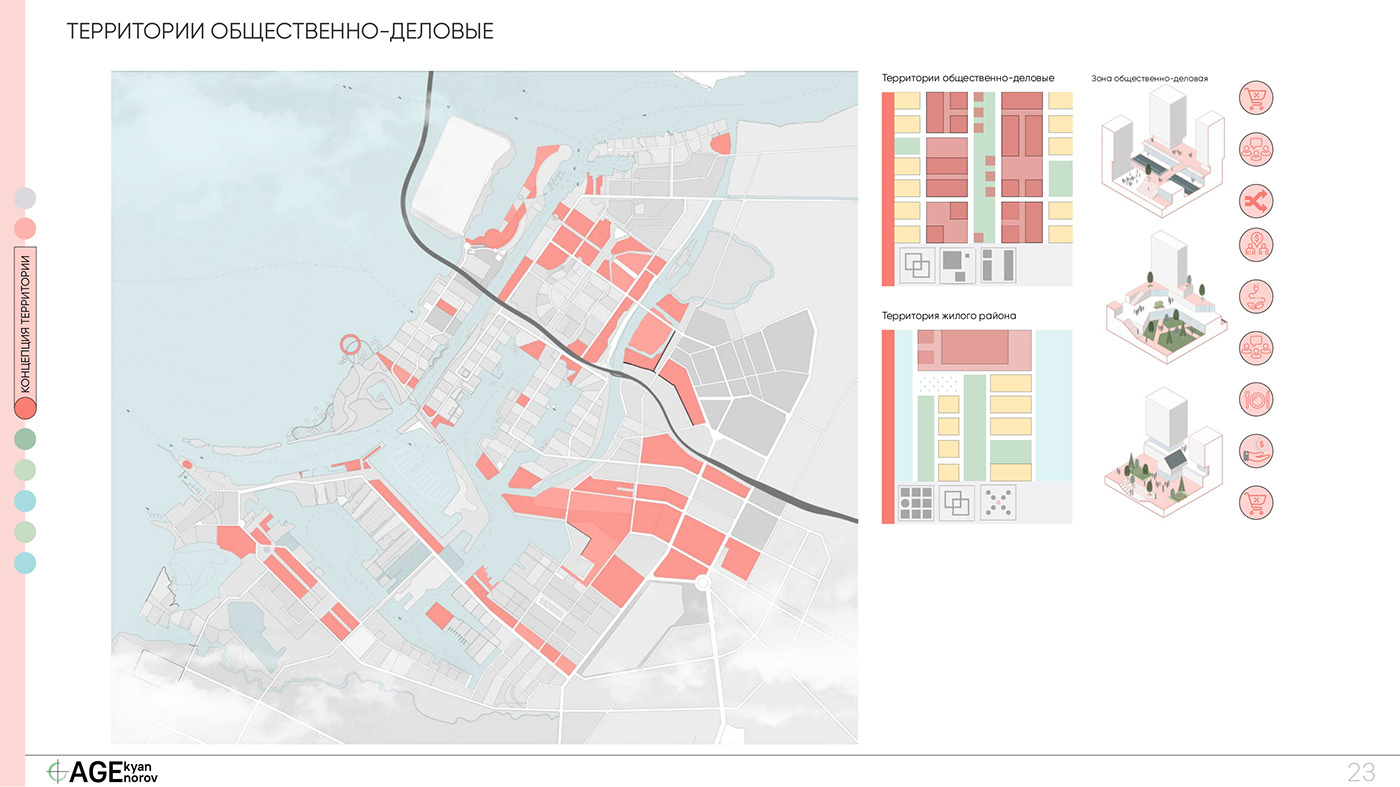






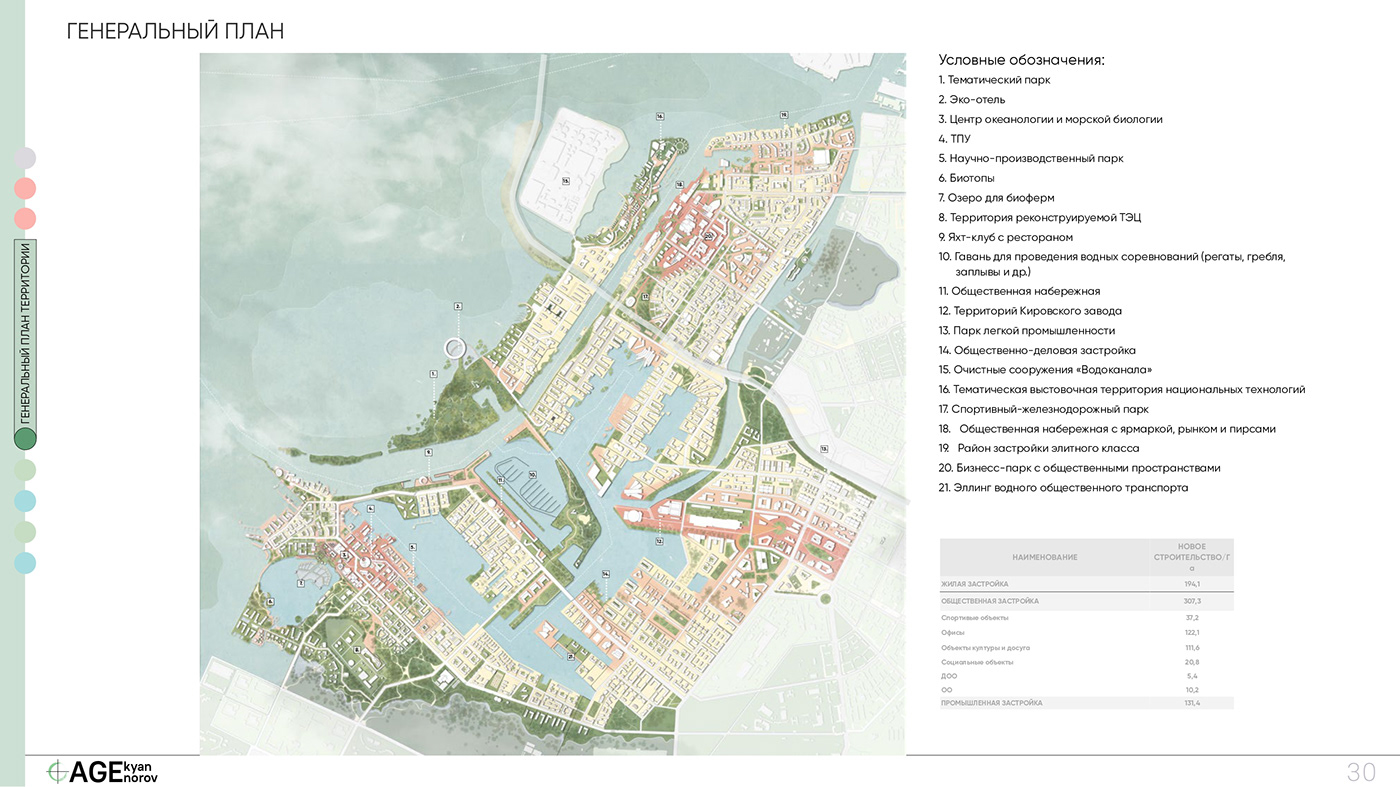





















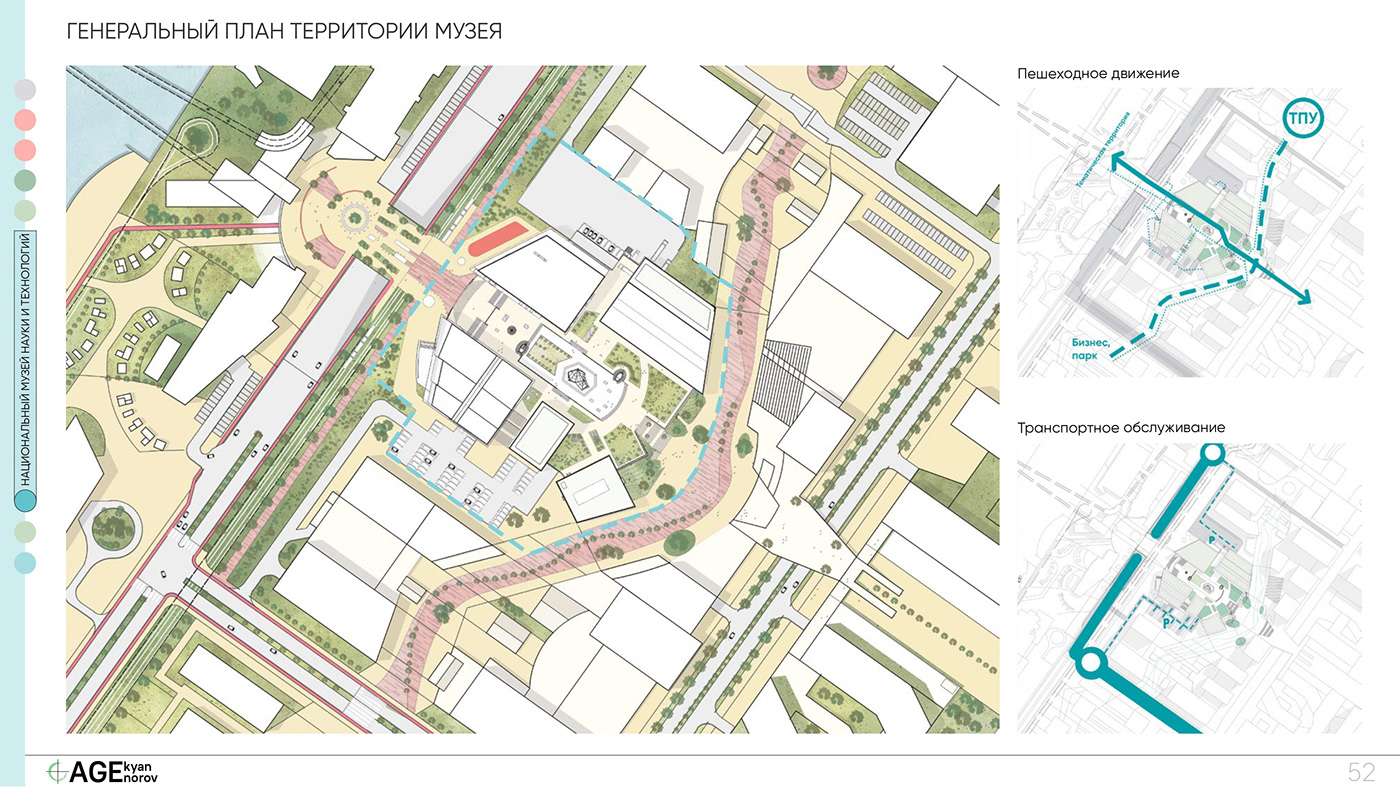
















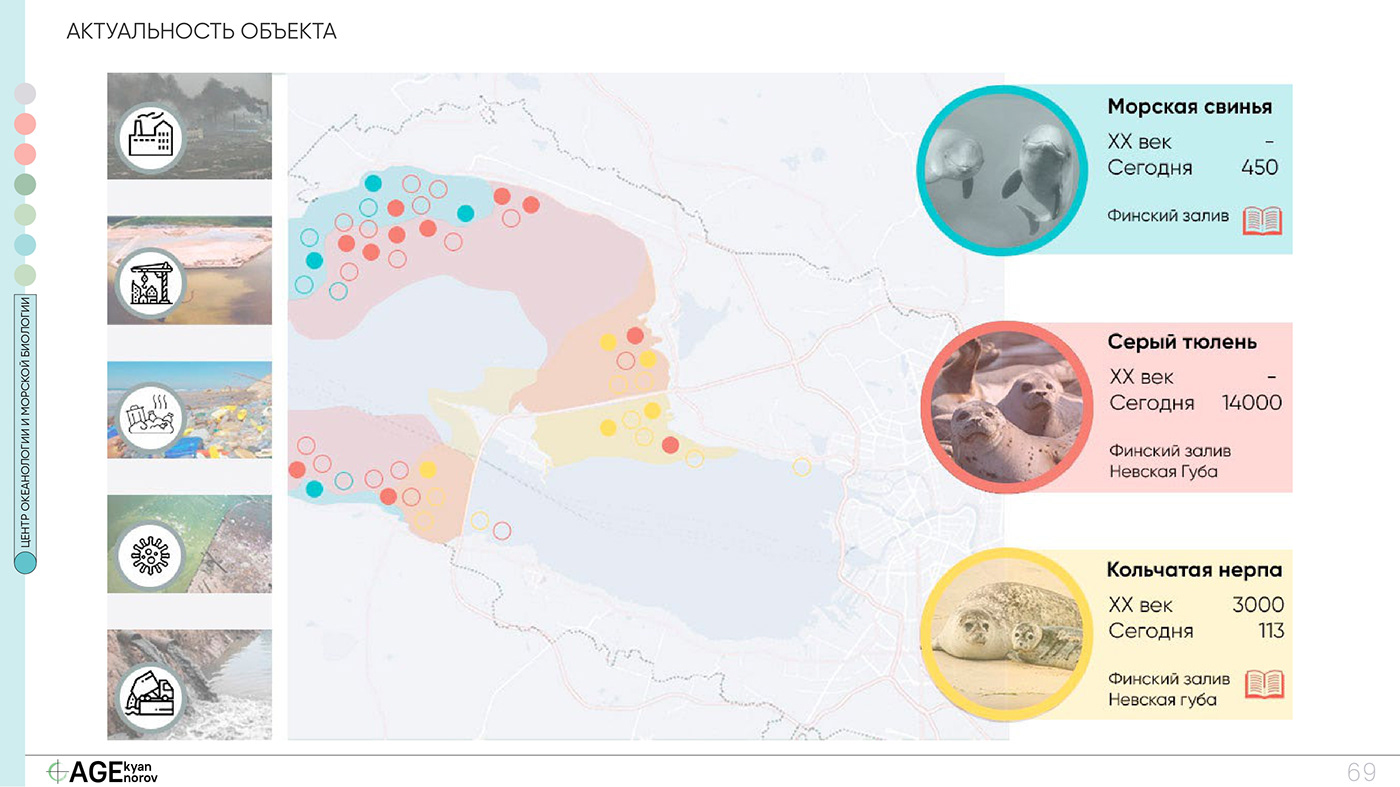



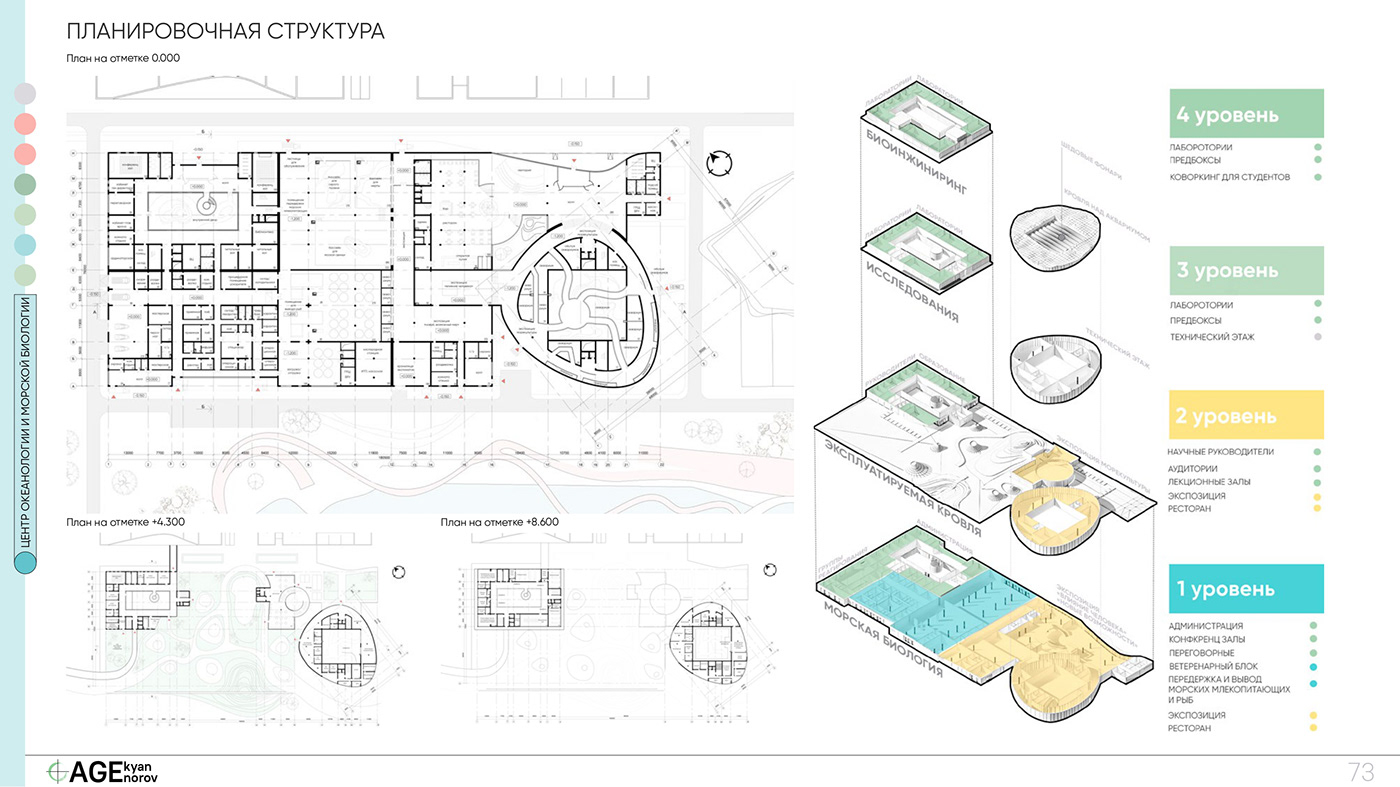




REVITALISATION OF THE AREA OF THE GREAT PORT OF ST.
PETERSBURG
The territory of the Big Sea Port is situated in the west of the city of St. Petersburg.
St. Petersburg and occupies the Kanonersky, Gutuevsky and Turukhtanniye islands as well as
Kirovsky Plant and Oil terminal areas. The coastline is 31 km long.
The 31 km long shoreline, washed by the Neva Bay, encloses a sizable
territory of about 600 hectares.
In the process of port development, the man-made territories have been steadily increased
territories and industrial development, destroying the natural recreational
framework and forming a depressive industrial image of the investigated part of the city.
city.
The main problem to date has been the isolation and
inaccessibility of the study area for both free access and
The main problem today is that the study area is inaccessible to the general public as well as to residential development.
A large port in St. Petersburg with a long historical past
should experience a renaissance process. A regeneration process based on
revitalisation and social adaptation of the port area and adjoining land.
land, while maintaining the spirit of the site with its unique port context.
A new round of development of this site will not only be an impetus for
the formation and maintenance of the city's historical heritage, but, by
the creation of multiple epicentres of development with different functional
(social and business in the north and west, cultural and recreational in the south)
to the north and west, and to the south - cultural and leisure). It will make it possible to create a fundamentally new unified social and
business fabric around the Neva Bay. Subsequently, the mutual expansion of
of the satellite epicentres, will create a single organism in the form of a new St. Petersburg
The most important aspect of development therefore becomes the creation of
sustainable urban development project, taking into account both
social needs as well as economic feasibility for the most
efficient use within the urban structure.
Through an interactive approach to the development of the Big Port, a space is created
space for city dwellers to choose their living environment and
the accessibility of the main core of the city, the projected site, provides
comfortable stay, both for work and for recreation, along the entire
perimeter of the water area and the city as a whole.
For this purpose a 'new city' is formed as a multifunctional object,
where each planning cell has its own objects of attraction, which, in turn
which, in turn, determine the emerging form of the area and its further
its further development.
Five functional areas are formed in the projected area
based on the existing natural and artificial boundaries of the Big Port of St. Petersburg
St. Petersburg and the adjacent residential and industrial zones: public, business, scientific and research, sports and wellness, sport and recreation zones.
business, research and development, sport and recreation, cultural and
recreational and cultural zones.
The first phase of the revitalisation includes the entire Gutuevsky Island as well as
the two largest stevedoring companies of the Big Port of St. Petersburg.
Petersburg, the entire Kanonersky Island with the exception of the existing residential
housing estate. Further reorganisation of the residential development of Kanonersky Island
Island as well as the territory of Kirovsky Plant and vast warehousing areas bordering residential areas.
territories bordering with residential areas in the West and South-West
of the study area. And then there is the area, which is home to
numerous large stevedoring companies, including the St. Petersburg
Oil Terminal.
PETERSBURG
The territory of the Big Sea Port is situated in the west of the city of St. Petersburg.
St. Petersburg and occupies the Kanonersky, Gutuevsky and Turukhtanniye islands as well as
Kirovsky Plant and Oil terminal areas. The coastline is 31 km long.
The 31 km long shoreline, washed by the Neva Bay, encloses a sizable
territory of about 600 hectares.
In the process of port development, the man-made territories have been steadily increased
territories and industrial development, destroying the natural recreational
framework and forming a depressive industrial image of the investigated part of the city.
city.
The main problem to date has been the isolation and
inaccessibility of the study area for both free access and
The main problem today is that the study area is inaccessible to the general public as well as to residential development.
A large port in St. Petersburg with a long historical past
should experience a renaissance process. A regeneration process based on
revitalisation and social adaptation of the port area and adjoining land.
land, while maintaining the spirit of the site with its unique port context.
A new round of development of this site will not only be an impetus for
the formation and maintenance of the city's historical heritage, but, by
the creation of multiple epicentres of development with different functional
(social and business in the north and west, cultural and recreational in the south)
to the north and west, and to the south - cultural and leisure). It will make it possible to create a fundamentally new unified social and
business fabric around the Neva Bay. Subsequently, the mutual expansion of
of the satellite epicentres, will create a single organism in the form of a new St. Petersburg
The most important aspect of development therefore becomes the creation of
sustainable urban development project, taking into account both
social needs as well as economic feasibility for the most
efficient use within the urban structure.
Through an interactive approach to the development of the Big Port, a space is created
space for city dwellers to choose their living environment and
the accessibility of the main core of the city, the projected site, provides
comfortable stay, both for work and for recreation, along the entire
perimeter of the water area and the city as a whole.
For this purpose a 'new city' is formed as a multifunctional object,
where each planning cell has its own objects of attraction, which, in turn
which, in turn, determine the emerging form of the area and its further
its further development.
Five functional areas are formed in the projected area
based on the existing natural and artificial boundaries of the Big Port of St. Petersburg
St. Petersburg and the adjacent residential and industrial zones: public, business, scientific and research, sports and wellness, sport and recreation zones.
business, research and development, sport and recreation, cultural and
recreational and cultural zones.
The first phase of the revitalisation includes the entire Gutuevsky Island as well as
the two largest stevedoring companies of the Big Port of St. Petersburg.
Petersburg, the entire Kanonersky Island with the exception of the existing residential
housing estate. Further reorganisation of the residential development of Kanonersky Island
Island as well as the territory of Kirovsky Plant and vast warehousing areas bordering residential areas.
territories bordering with residential areas in the West and South-West
of the study area. And then there is the area, which is home to
numerous large stevedoring companies, including the St. Petersburg
Oil Terminal.
Translated with www.DeepL.com/Translator (free version)
РЕВИТАЛИЗАЦИЯ ТЕРРИТОРИИ БОЛЬШОГО ПОРТА САНКТ-
ПЕТЕРБУПГА
Территория Большого Морского порта находится на западе г. Санкт-
Петербург и занимает Канонерский, Гутуевский, Турухтанные острова, а также
участки Кировского завода и Нефтяного терминала. Береговая линия
протяженностью 31 км, омываемая Невской губой, замыкает внушительную
территория порядка 600 Га.
В процессе освоения порта постоянно увеличивались искусственные
территории и промышленная застройка, уничтожая естественный рекреационный
каркас и формируя депрессивный промышленный облик исследуемой части
города.
Основной проблемой на сегодняшний день стали изолированность и
недоступность исследуемой территории как для свободного посещения, так и для
жилой застройки.
Большой порт в Санкт-Петербурге с многовековым историческим прошлым
должен испытать процесс возрождения. Процесс возрождения, основанный на
ревитализации и социальной адаптации территории порта и прилегающих к нему
земель, с сохранением духа этого места с его уникальным портовым контекстом.
Новый виток развития данной площадки станет не только импульсом для
формирования и поддержания исторического наследия города, но, благодаря
созданию многочисленных эпицентров развития с различным функциональным
наполнением (на севере и западе общественно-деловым, а на юге культурно-
досуговым). Позволит выработать принципиально новую единую общественно-
деловую ткань вокруг Невской Губы. Впоследствии, взаимное расширение
эпицентров-спутников, создаст единый организм в виде нового Петербурга
Таким образом, важнейшим аспектом развития становится создание
устойчивого проекта градостроительного развития, учитывающего как
социальные потребности, так и экономическую целесообразность для наиболее
эффективного использования в рамках городской структуры.
За счет интерактивного подхода к развитию Большого порта создается
пространство для выбора горожанином своей среды жизнедеятельности, а
доступность главного ядра города – проектируемой площадки, обеспечивает
комфортное пребывание как в условиях труда, так и для отдыха людей по всему
периметру акватории и города в целом.
Для этого формируется «новый город», как многофункциональный объект,
где каждая планировочная ячейка имеет свои объекты притяжения, которые, в
свою очередь, определяют формируемый облик территории и ее дальнейшее
развитие.
На проектируемом участке формируется пять функциональных районов
исходя из существующих естественных и искусственных границ Большого порта
Санкт-Петербург и прилегающих жилых и промышленных зон: общественно-
деловая, научно-исследовательская, спортивно-рекреационная, культурно-
досуговая.
Первый этап ревитализации включает в себя весь Гутуевский остров, а
также две самые крупные стивидорные компании Большого порта Санкт-
Петербург, весь Канонерский остров за исключением существующей жилой
застройки. Далее планируется реорганизовать жилую застройку Канонерского
острова, а также территорию Кировского завода и обширные складские
территории, граничащие с жилой застройкой на Западе и Юго-Западе
исследуемой территории. И после территорию, на которой расположено
множество крупных стивидорных компаний, в том числе Петербургский
Нефтяной терминал.
ПЕТЕРБУПГА
Территория Большого Морского порта находится на западе г. Санкт-
Петербург и занимает Канонерский, Гутуевский, Турухтанные острова, а также
участки Кировского завода и Нефтяного терминала. Береговая линия
протяженностью 31 км, омываемая Невской губой, замыкает внушительную
территория порядка 600 Га.
В процессе освоения порта постоянно увеличивались искусственные
территории и промышленная застройка, уничтожая естественный рекреационный
каркас и формируя депрессивный промышленный облик исследуемой части
города.
Основной проблемой на сегодняшний день стали изолированность и
недоступность исследуемой территории как для свободного посещения, так и для
жилой застройки.
Большой порт в Санкт-Петербурге с многовековым историческим прошлым
должен испытать процесс возрождения. Процесс возрождения, основанный на
ревитализации и социальной адаптации территории порта и прилегающих к нему
земель, с сохранением духа этого места с его уникальным портовым контекстом.
Новый виток развития данной площадки станет не только импульсом для
формирования и поддержания исторического наследия города, но, благодаря
созданию многочисленных эпицентров развития с различным функциональным
наполнением (на севере и западе общественно-деловым, а на юге культурно-
досуговым). Позволит выработать принципиально новую единую общественно-
деловую ткань вокруг Невской Губы. Впоследствии, взаимное расширение
эпицентров-спутников, создаст единый организм в виде нового Петербурга
Таким образом, важнейшим аспектом развития становится создание
устойчивого проекта градостроительного развития, учитывающего как
социальные потребности, так и экономическую целесообразность для наиболее
эффективного использования в рамках городской структуры.
За счет интерактивного подхода к развитию Большого порта создается
пространство для выбора горожанином своей среды жизнедеятельности, а
доступность главного ядра города – проектируемой площадки, обеспечивает
комфортное пребывание как в условиях труда, так и для отдыха людей по всему
периметру акватории и города в целом.
Для этого формируется «новый город», как многофункциональный объект,
где каждая планировочная ячейка имеет свои объекты притяжения, которые, в
свою очередь, определяют формируемый облик территории и ее дальнейшее
развитие.
На проектируемом участке формируется пять функциональных районов
исходя из существующих естественных и искусственных границ Большого порта
Санкт-Петербург и прилегающих жилых и промышленных зон: общественно-
деловая, научно-исследовательская, спортивно-рекреационная, культурно-
досуговая.
Первый этап ревитализации включает в себя весь Гутуевский остров, а
также две самые крупные стивидорные компании Большого порта Санкт-
Петербург, весь Канонерский остров за исключением существующей жилой
застройки. Далее планируется реорганизовать жилую застройку Канонерского
острова, а также территорию Кировского завода и обширные складские
территории, граничащие с жилой застройкой на Западе и Юго-Западе
исследуемой территории. И после территорию, на которой расположено
множество крупных стивидорных компаний, в том числе Петербургский
Нефтяной терминал.








